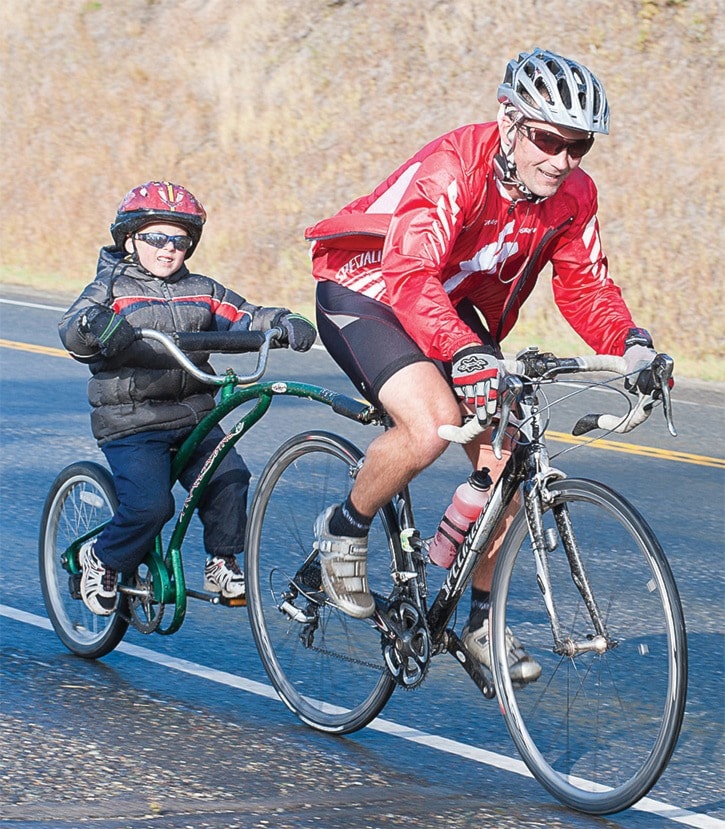If you have already registered to participate in this year’s Tour de Cariboo on Sept. 7, congratulations.
If you are still on the fence and uncertain of whether you have the right equipment, bike fit, or worried about how to train in order to feel prepared to complete the distance, don’t worry — there is more information to come to put you at ease and motivate you to commit to participating in this great event.
Are you in the market for a new bike?
There really is nothing more important for creating a great cycling experience than matching yourself, — your body, goals and dreams — to the right bike. There are a variety of ways to fit a bike and since everyone and every type of bike is different, sometimes it’s easiest to speak to someone with years of experience. This will allow them to identify a bike that will suit your needs, goals and expectations. Scott Gordon at Barking Spider and Mark Savard at Red Shred’s are both excellent resources in Williams Lake.
For those of you who already have a bike here are some basic tips. A proper bike fit is essential to minimize your risk of injury and maximize both comfort and efficiency of your ride. Remember — these are good general guidelines, but the ultimate no. 1 rule with bike fitting is comfort.
The first step to proper bike fit is to make sure you have the right frame size. Stand over your bike’s top tube (in between the saddle and handlebars). The general rule-of-thumb for road biking is to have roughly one inch of clearance between your buttocks and the frame, for mountain biking on trails, you should have two to six inches depending on the terrain.
From here, we are going to discuss the proper set up for road riding. What you will need is your bike, a helper (friend, family or volunteer) and a plumb line. The first step is finding the appropriate saddle height. Sit on the saddle with your hips parallel to the ground. Place the crank arms of the pedals in line with the seat tube (your feet are at a 12 and 6 o’clock position). When your foot is at the 6 o’clock position, you should have a slight bend in the knee — approximately 10 degrees is desired.
When making saddle height adjustments, make them slowly, as even a one-centimeter adjustment can have a drastic effect on how the bike feels and it may alter how stress is placed through the knees.
Next is to adjust the fore/aft saddle position and saddle level. To do this you want to place the crank arms of the pedals so they are parallel with the ground (feet in 9 and 3 o’clock position). Have the helper drop a plumb line from the front of the knee that is in the 3 o’clock position down to the ground. The plumb line should fall through the center of the pedal (pedal axle). If it falls in front of the pedal, you will need to move the saddle back a little and conversely, if it falls behind, you will need to move the saddle forward a little. For saddle level, as a general rule, it’s always best to start with the saddle in a perfectly level position. If you are sliding forward from a forward-tilted saddle your neck, arms and back will be taking more stress and strain, and if the saddle is tilted backwards, you may place undue strain on your low back.
When you lean forward, placing your hands on the handlebars, the handlebar should obscure your view of the front hub. If the hub is in front of the handlebar, you will need a slightly shorter stem and if the handlebar is behind, you will need a slightly longer stem. The body angle when hands are on the handlebars should be approximately 45 degrees; however, this varies depending on the type of bike and the fitness level of cyclist. If you are a competitive cyclist, you may want a slightly steeper angle for better aerodynamics whereas if you are into touring or new to cycling, a more relaxed angle is more comfortable. Lastly, if you ride a bike with clip-less pedals, determining the position of the cleats on your cycling shoes is very important. Misaligned cleats can put stress through all joints of the lower body.
The cleat should contact the pedal at the ball of your foot and the feet should point forward when clipped into the pedals.
A bike helmet is mandatory. The helmet should fit snug, touching the head all the way around. It should sit level with the chinstrap comfortably snug and stable enough that it remains in place in the event of a fall. Additional equipment to discuss — need to have and nice to have — include padded gloves, padded cycling shorts, a multi-tool, pump, spare tube and tire levers. Padded gloves are helpful in absorbing vibration and preventing road rash. Padded cycling shorts are a great investment especially for longer rides. Carrying a multi-tool, pump, spare tube and tire levers will ensure you have the tools necessary to change a flat tire and tighten any component on the bike that may work its way loose. Do remember that the tour does provide support drivers with the tools to help you out if you or your bike experience any distress.
For more information or clarification, there are many helpful resources online by searching key words “bike fitting.”
To register for the Tour de Cariboo, contact Williams Lake Big Brothers and Big Sisters at 250-398-8391 or on-line at www.bbswlake.com. Pledges can also be collected on-line.
Stay tuned for an upcoming article on training tips.
Happy Riding!
Brittany Klingmann, MPT, BSc Kin, CAFCI
Registered Physiotherapist
